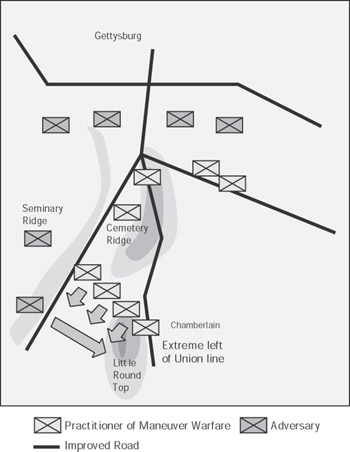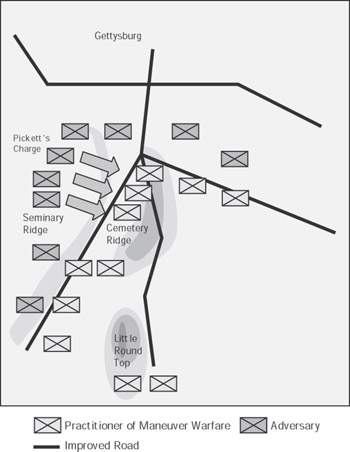Chamberlain and Pickett at Gettysburg
Colonel Joshua Chamberlain s defense of Little Round Top and Major General George Pickett s charge on Cemetery Ridge, which occurred within just twenty-four hours of each other during the Battle of Gettysburg in 1863, could not be further apart in illustrating the appropriate weighing of risk and reward. Chamberlain s stand prevented the collapse of the Union line. Pickett s tragic charge was what historians often call the High Water Mark of the Confederacy ”the last time the South would be a viable threat to the Union.
Chamberlain
Chamberlain s 20th Maine Regiment guarded the extreme left flank of the Union line during the Battle of Gettysburg. Greatly outnumbered by the attacking Confederates and relatively inexperienced, the 20th Maine repulsed several attacks on July 2, 1863, and denied the enemy the exposed Union flank on the rocky hill known as Little Round Top. Holding this hill was a strategic necessity for the North, as it anchored the Union line. Taking Little Round Top would have enabled Confederate forces to attack the exposed flank of the Union line. Losing the hill would have been disastrous for the Union.
By late afternoon of July 2, the 20th Maine had suffered heavy casualties, and ammunition was dwindling. Expecting yet another onslaught of Confederate troops, Chamberlain steadfastly ordered his men to hold fire, then fix bayonets, and, at the last second, charge! His motivated men formed a line and charged down the hill headlong into the advancing Confederate force. Chamberlain s bold plan risked his entire unit, and casualties were high ”one-third of the remaining regiment. But the 20th Maine shattered the Confederate advance and altered the course of battle in the Union s favor.

Figure 5.3: Chamberlain at Gettysburg, July 2, 1863
Pickett

Figure 5.4: Pickett s Charge, July 3, 1863
On the eve of July 3, General Robert E. Lee was exasperated after two days of unproductive sparring intended to break the Union defensive front. He therefore devised a grandiose plan to send Pickett s division en masse across an open field to strike the center of the Union line, high atop an expanse known as Cemetery Ridge. Many Confederate leaders considered the plan suicidal. Lieutenant General James Longstreet, Pickett s direct superior , pleaded with Lee, General, I have been a soldier all my life. I have been with soldiers engaged in fights by couples, by squads, companies, regiments, divisions, and armies, and should know as well as anyone what soldiers can do. It is my opinion that no 15,000 men ever arrayed for battle can take that position. [6]
Despite Longstreet s misgivings, on July 3 Lee decided to press onward with the attack ”with no credible exploitation plan should Pickett succeed. At 1:00 p.m., Pickett led his division on the fateful charge. Fully exposed to the enemy in the open grassy field through which they marched in the attack, Pickett s men faced devastating enemy fire from multiple angles and were cut down by brutal Union cannonade and sniper fire. After two hours Pickett ordered retreat and returned to the bottom of the hill to report to General Lee ”with 10,000 fewer men than he had had at the outset. Immediately following the battle, Lee accepted complete blame for the disaster: Come, General Pickett, this has been my fight, and the blame rests on my shoulders. [7] The slaughter cost Lee nearly one-third of his army, leaving him in no position to attack again and forcing him to retreat quietly across the Mason-Dixon line, never to threaten northern soil again.
Leadership Lessons
Chamberlain s decision to fix bayonets serves as an excellent example of a judicious risk-reward trade-off. The risk of losing most ”if not all ”of his remaining men had to be taken to deny the enemy access to the highly strategic Union flank. The entire Union line could have been rolled up from the commanding position provided by Little Round Top; instead, Chamberlain s embattled regiment turned the tide of the battle.
In contrast, even if Pickett had managed to defy the odds and take Cemetery Ridge, Confederate forces were not positioned to exploit the opening before the massive Union Army could close off the gap. There would have been no gain commensurate with the risks that Lee and Pickett were assuming . Thus Lee s acceptance of risk ”the loss of an entire division in the face of insurmountable odds and with little potential gain ”is a puzzling but clear example of a poor risk-reward trade-off. It is also an example of how not to unfreeze a static front: Pickett s force shattered when it was hurled headlong into the Union defensive line.
[6] Johnson, Curt, and McLaughlin, Mark, Battles of the Civil War: From Bull Run to Petersburg: Four Hard Years of Strategy and Bloodshed , 92.
[7] Davis, Burke, Gray Fox , 246.
EAN: 2147483647
Pages: 145